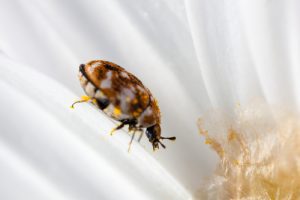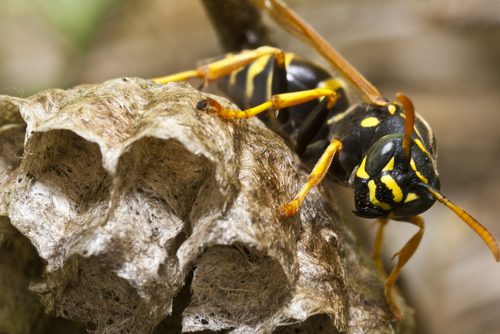Bee or Wasp Nests Can Be the Source of Carpet Beetles
By Chris Williams on December 30, 2011.
Q. A couple of months ago, we had a serious problem with carpet beetles in an upstairs bedroom. A pest control company checked everything in the room and treated twice but we kept seeing the tiny beetles. During the summer, we had honey bees nesting in the attic above that room. We didn’t want to kill the bees, so we had a beekeeper collect them. Could there be some kind of connection? Can carpet beetles come from bee nests?
 A. Carpet beetles can, and do, come from the nests of bees and wasps, as well as the nests of birds, and other animals. In nature, carpet beetles recycle animal matter, feeding on dead animals and insects, shed hair, and feathers. So, major carpet beetle infestations often come from such things as a mouse nest behind a kitchen pantry, a dead squirrel in a chimney, a bird nesting in a vent, or a recently-exterminated wasp nest in a wall void. Carpet beetle larvae in the bees’ nest would feed on beeswax, pollen, and dead bees. Once the bees are removed, carpet beetle larvae wander looking for new food sources or pupation sites, and can end up in the rooms below. Adult carpet beetles that emerge in the attic may also find their way below looking for places in which to lay eggs.
A. Carpet beetles can, and do, come from the nests of bees and wasps, as well as the nests of birds, and other animals. In nature, carpet beetles recycle animal matter, feeding on dead animals and insects, shed hair, and feathers. So, major carpet beetle infestations often come from such things as a mouse nest behind a kitchen pantry, a dead squirrel in a chimney, a bird nesting in a vent, or a recently-exterminated wasp nest in a wall void. Carpet beetle larvae in the bees’ nest would feed on beeswax, pollen, and dead bees. Once the bees are removed, carpet beetle larvae wander looking for new food sources or pupation sites, and can end up in the rooms below. Adult carpet beetles that emerge in the attic may also find their way below looking for places in which to lay eggs.
There are three different species of carpet beetle that look very much alike. Adult beetles are tiny, 1/16 to 1/8 inch long, and rounded in shape. Each species has a distinctive “calico” coloration of splotches of black, brown, white, yellow, and reddish-orange. Carpet beetle larvae are yellow-brown, about 1/4 inch long, and covered with bristly hairs. The larvae avoid light and remain hidden, while the adult beetles fly to lights and windows after they emerge.
If you’re lucky, the carpet beetles have been confined to that bedroom. If you’re unlucky, you could soon have carpet beetle problems in other areas of the house. Unfortunately, carpet beetle larvae can feed on many things in your home. The emerging female beetles will lay their eggs on materials suitable for larval food which can include wool carpet, soiled fabrics, hair, hides, felt, dead animals and insects, and occasionally on stored food. In addition to animal nests, carpet beetle larvae can also be found feeding on the underside of wool carpets, in stored woolens, stuffed furniture, in dry pet food, or scavenging along baseboards, behind furniture, in voids—wherever hair, lint, dead insects, and crumbs accumulate. Frequent and thorough vacuuming will help to prevent and remove carpet beetle infestations.
 It’s the carpet beetle larvae that do the feeding damage. They eat irregular holes in fabrics, they clip the tips off of fur, hair and bristles. They also eat slits in wool or wool blend carpeting. In heavy infestations, you may find an accumulation of shed larval skins.
It’s the carpet beetle larvae that do the feeding damage. They eat irregular holes in fabrics, they clip the tips off of fur, hair and bristles. They also eat slits in wool or wool blend carpeting. In heavy infestations, you may find an accumulation of shed larval skins.
If carpet beetles continue to be a problem in the future, give Colonial a call. We can find where the larvae are feeding in your home, remove that food source, and can treat surrounding areas. Our trained technicians can also treat your attic to kill any remaining carpet beetles and can pest-proof your home to keep bees from nesting there in the future.